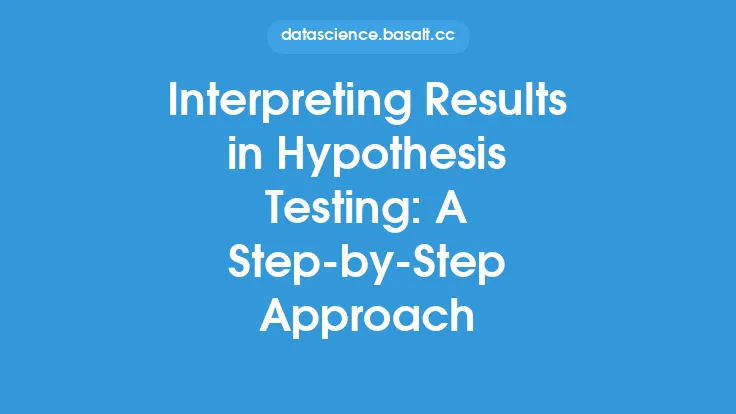Conducting hypothesis tests is a crucial aspect of statistical analysis, allowing researchers to make informed decisions based on data-driven insights. A hypothesis test is a systematic procedure used to determine whether a hypothesis is supported or rejected based on sample data. To ensure the validity and reliability of the results, it is essential to follow best practices when conducting hypothesis tests. In this article, we will provide a step-by-step approach to conducting hypothesis tests, highlighting key considerations and technical aspects to ensure accurate and meaningful results.
Introduction to Hypothesis Testing
Hypothesis testing involves formulating a null hypothesis (H0) and an alternative hypothesis (H1), which are mutually exclusive statements about a population parameter. The null hypothesis typically represents a statement of no effect or no difference, while the alternative hypothesis represents a statement of an effect or difference. The goal of hypothesis testing is to determine whether the sample data provide sufficient evidence to reject the null hypothesis in favor of the alternative hypothesis.
Step 1: Formulate the Hypotheses
The first step in conducting a hypothesis test is to formulate the null and alternative hypotheses. The null hypothesis should be a clear and concise statement about the population parameter, while the alternative hypothesis should be a statement that contradicts the null hypothesis. For example, suppose we want to determine whether the average height of a population is greater than 175 cm. The null hypothesis would be H0: μ ≤ 175, and the alternative hypothesis would be H1: μ > 175.
Step 2: Choose a Significance Level
The significance level, denoted by α, is the probability of rejecting the null hypothesis when it is true. The choice of significance level depends on the research question and the consequences of making a Type I error (rejecting a true null hypothesis). Common significance levels are 0.05, 0.01, and 0.001. A smaller significance level reduces the risk of making a Type I error but increases the risk of making a Type II error (failing to reject a false null hypothesis).
Step 3: Select a Test Statistic
The test statistic is a numerical value that summarizes the sample data and is used to determine whether the null hypothesis should be rejected. The choice of test statistic depends on the type of data, the research question, and the level of measurement. Common test statistics include the z-score, t-score, and F-score. For example, if we want to compare the means of two independent samples, we would use the t-score as the test statistic.
Step 4: Calculate the Test Statistic
Once the test statistic is selected, it must be calculated using the sample data. The calculation of the test statistic depends on the type of test and the level of measurement. For example, if we are conducting a t-test to compare the means of two independent samples, we would calculate the t-score using the formula: t = (x̄1 - x̄2) / sqrt(s1^2 / n1 + s2^2 / n2), where x̄1 and x̄2 are the sample means, s1 and s2 are the sample standard deviations, and n1 and n2 are the sample sizes.
Step 5: Determine the Critical Region
The critical region is the range of values of the test statistic that leads to the rejection of the null hypothesis. The critical region depends on the significance level, the type of test, and the level of measurement. For example, if we are conducting a two-tailed t-test with a significance level of 0.05, the critical region would be the range of values of the t-score that are less than -1.96 or greater than 1.96.
Step 6: Calculate the P-Value
The p-value is the probability of obtaining a test statistic at least as extreme as the one observed, assuming that the null hypothesis is true. The p-value is used to determine whether the null hypothesis should be rejected. If the p-value is less than the significance level, the null hypothesis is rejected. For example, if the p-value is 0.03 and the significance level is 0.05, the null hypothesis is rejected.
Step 7: Interpret the Results
The final step in conducting a hypothesis test is to interpret the results. If the null hypothesis is rejected, it means that the sample data provide sufficient evidence to support the alternative hypothesis. If the null hypothesis is not rejected, it means that the sample data do not provide sufficient evidence to support the alternative hypothesis. It is essential to consider the limitations of the study, the sample size, and the level of measurement when interpreting the results.
Additional Considerations
In addition to the steps outlined above, there are several additional considerations to keep in mind when conducting hypothesis tests. These include:
- Assumptions: Hypothesis tests rely on certain assumptions about the data, such as normality, independence, and homoscedasticity. It is essential to check these assumptions before conducting the test.
- Sample size: The sample size affects the power of the test and the accuracy of the results. A larger sample size provides more precise estimates and increases the power of the test.
- Level of measurement: The level of measurement affects the choice of test statistic and the interpretation of the results. For example, if the data are ordinal, a non-parametric test may be more appropriate.
- Multiple testing: When conducting multiple tests, the significance level should be adjusted to account for the increased risk of making a Type I error.
Conclusion
Conducting hypothesis tests is a systematic procedure that requires careful consideration of several factors, including the formulation of hypotheses, the choice of significance level, the selection of a test statistic, and the interpretation of results. By following the steps outlined in this article and considering additional factors, researchers can ensure the validity and reliability of their results and make informed decisions based on data-driven insights. Remember to always check assumptions, consider the sample size and level of measurement, and adjust for multiple testing to ensure accurate and meaningful results.





